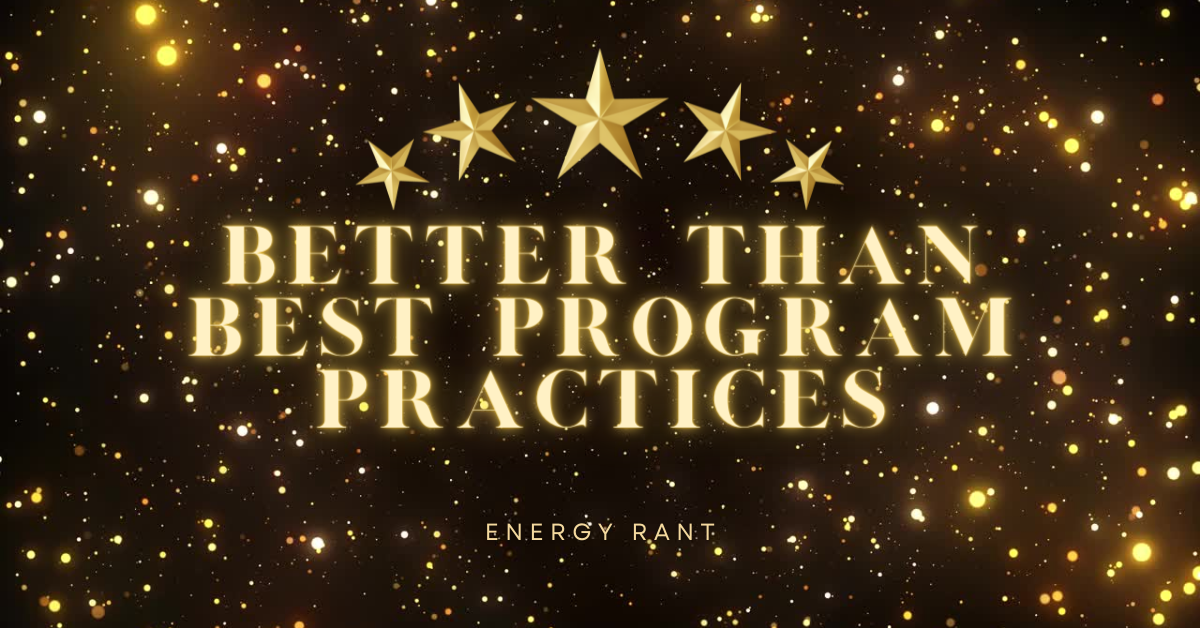
When Val Jenson talks, I listen. When he writes, I read. His recent article in Energy Central triggered an avalanche of ideas for a program, portfolio, and industry overhaul needed to get us there, which is the next level of savings equal to the last 25 years of lighting replacements and retrofits. Those days are gone, and unfortunately, the line of thinking that got us here (light bulbs) won’t get us there.
Downstream Days are Numbered
Let’s start with my favorite need for an overhaul, which is my greatest peeve – rebates and cash incentives to customers, known as a downstream program, are dumb. Yet evaluators have an enormous propensity for determining program impacts, as in what the program achieved by asking customers about how their incentive cajoled them to their decision.
I’ve completed four major efficiency projects in my home: a variable refrigerant flow cold-weather heat pump, a top-of-the-line condensing boiler, replaced all windows with low-emissivity and low U-value windows (ENERGY STAR qualified), and nailed rigid insulation to the ceiling in my knee-wall attic spaces. I got a few hundred bucks for the $14,000 heat pump and $10,000 boiler. Those incentives don’t move the needle for me or anyone else; it’s just a wealth transfer from my neighbors to me. On the other hand, I got bupkis for the insulation, windows, and oops, the fifth, replacing all my lights (some of which were incandescent halogen) with LED.
The root of this farse is the archaic notion that customers pay into the portfolio and, therefore, must get the money back. The reality is that this is simply a no-difference-making wealth transfer. What is a midstream program? It’s a market transformation program that redirects incentives away from customers to wholesalers and contractors so they can afford the cost premium to stock higher efficiency equipment than they otherwise would. That efficient equipment is then installed in planned or emergency replacement or new construction scenarios. In mid/upstream cases, a few hundred bucks can make a difference.
My bet is that the net-to-gross ratio, which measures the program’s influence on customer actions (I did not say “decision” on purpose), is nearly the same for a downstream wealth transfer program as it is for a midstream program. How can that be? It’s a crock because contractors persuade customers to go with the status quo all the time because they don’t stock efficient equipment, they don’t try new things because they have no incentive to do so, and time to completion rules their business model. What’s your source, Jeff? Conversations with equipment vendors and efficiency-minded customers, especially in larger cities where contractors care less about customer experience or desires.
Is anyone evaluating why customers end up with cheap and crappy? I don’t think so. It is like trying to find why EV buyers chose electric. All you can find is why customers do not go electric. Those reasons are obvious. Provide something we don’t know. We call it useful research.
Information and Services
Customers, including me, can use information and services to make efficiency easy. I have a couple of cars with semi-sophisticated brain centers for climate control, navigation, and entertainment. At most, I use 10% of it. As mentioned in an earlier post, I don’t know how to shut the VW radio off, so I turn the volume to zero. My iPhone provides my entertainment, podcasts, Sirius satellite radio, navigation, and even pinpoint outdoor temperature for my beloved 2003 Acura that has no outdoor temperature reading.
Do ya think millions of gadgets and control systems go woefully underutilized? There are also countless tools available for customers – like dashboards on energy usage in real-time to manage demand and reduce energy consumption. Val mentions some of this: “Granular energy use data can yield very specific insights about how a customer uses electricity and where opportunities for reducing/shifting use can be found.”
There are many things people can figure out on their own, like building and refurbishing furniture. Not for me. Thanks. Programming my boiler for resets and efficiency, on the other hand, is easy for me, and I’d rather do it myself to bleed every drop from the turnip.
Customers focus on what they do, whether it’s teaching children, manufacturing pharmaceuticals, or making a frozen pizza. Employees are swamped with their core duties, even though they may be interested in reducing cost, which flows straight to the bottom line as profit. But they don’t have the time, want to take the time, or have nerdy interests in finding energy management tools to get there. They will do the right thing for their companies if they have the right information. They need information more than they need wealth transfers – a course (direction) to make decisions on their journey to better business and energy savings.
As far as the incentive is concerned, how about paying customers for their time rather than aimless incentives? That may be hard to measure, but if the incentive is rebranded as paying customers for their time, it could be a psychological game changer.
I’m just getting started. More to come.





